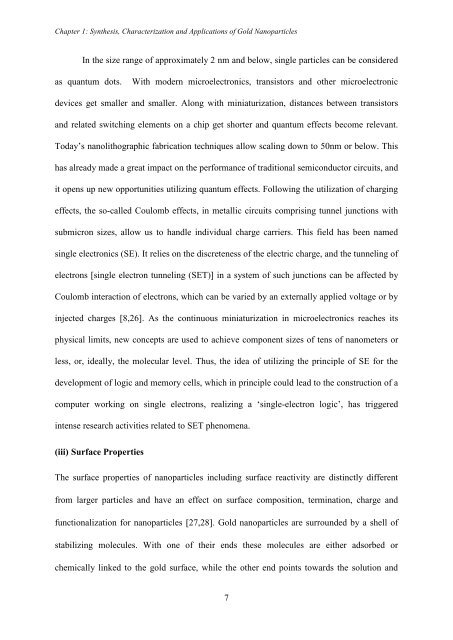PHYS01200704032 Debes Ray - Homi Bhabha National Institute
PHYS01200704032 Debes Ray - Homi Bhabha National Institute
PHYS01200704032 Debes Ray - Homi Bhabha National Institute
Create successful ePaper yourself
Turn your PDF publications into a flip-book with our unique Google optimized e-Paper software.
Chapter 1: Synthesis, Characterization and Applications of Gold Nanoparticles<br />
In the size range of approximately 2 nm and below, single particles can be considered<br />
as quantum dots.<br />
With modern microelectronics, transistors and other microelectronic<br />
devices get smaller and smaller. Along with miniaturization, distances between transistors<br />
and related switching elements on a chip get shorter and quantum effects become relevant.<br />
Today‟s nanolithographic fabrication techniques allow scaling down to 50nm or below. This<br />
has already made a great impact on the performance of traditional semiconductor circuits, and<br />
it opens up new opportunities utilizing quantum effects. Following the utilization of charging<br />
effects, the so-called Coulomb effects, in metallic circuits comprising tunnel junctions with<br />
submicron sizes, allow us to handle individual charge carriers. This field has been named<br />
single electronics (SE). It relies on the discreteness of the electric charge, and the tunneling of<br />
electrons [single electron tunneling (SET)] in a system of such junctions can be affected by<br />
Coulomb interaction of electrons, which can be varied by an externally applied voltage or by<br />
injected charges [8,26]. As the continuous miniaturization in microelectronics reaches its<br />
physical limits, new concepts are used to achieve component sizes of tens of nanometers or<br />
less, or, ideally, the molecular level. Thus, the idea of utilizing the principle of SE for the<br />
development of logic and memory cells, which in principle could lead to the construction of a<br />
computer working on single electrons, realizing a „single-electron logic‟, has triggered<br />
intense research activities related to SET phenomena.<br />
(iii) Surface Properties<br />
The surface properties of nanoparticles including surface reactivity are distinctly different<br />
from larger particles and have an effect on surface composition, termination, charge and<br />
functionalization for nanoparticles [27,28]. Gold nanoparticles are surrounded by a shell of<br />
stabilizing molecules. With one of their ends these molecules are either adsorbed or<br />
chemically linked to the gold surface, while the other end points towards the solution and<br />
7

















